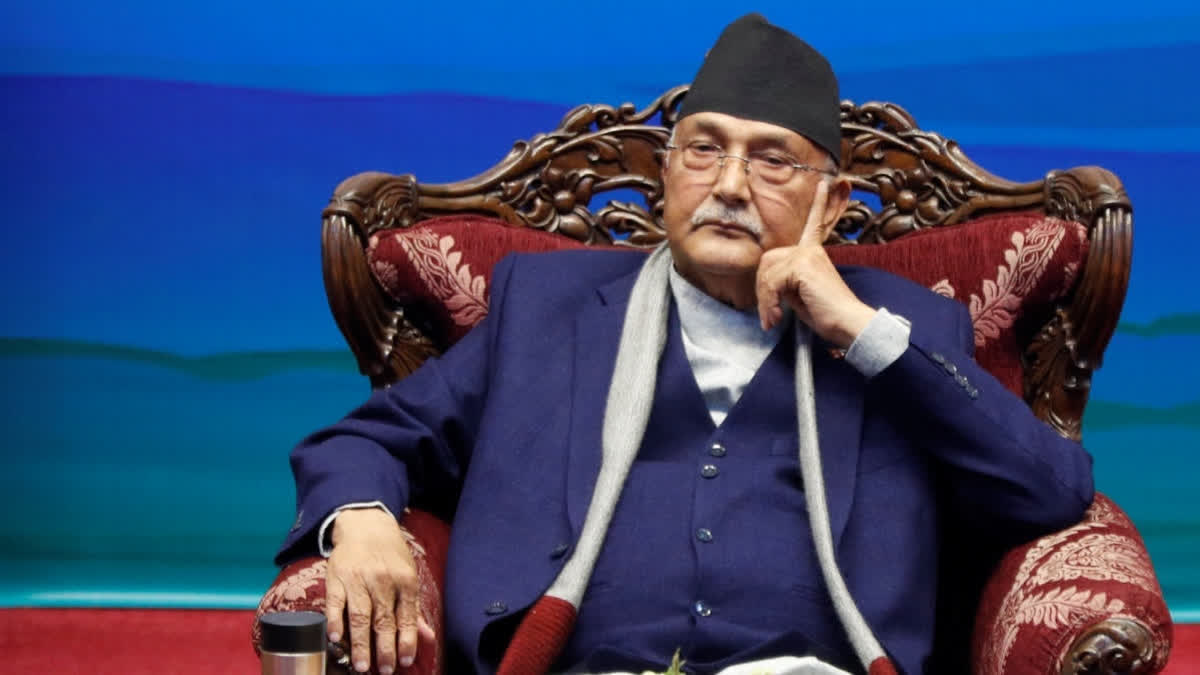New Delhi: Ahead of Nepal Prime Minister KP Sharma Oli’s visit to China next month, the Nepali Congress and the Communist Party of Nepal-United Marxist Leninist (CPN-UML), the two partners in the ruling coalition government in the Himalayan nation, are finally coming on the same page after weeks of negotiations about implementation of Beijing’s Belt and Road Initiative (BRI) projects.
Even as Foreign Minister Arzu Rana Deuba left for China on Thursday to lay the groundwork for Oli’s visit to China, the Nepali Congress and the CPN-UML have come to an understanding that specific BRI projects in Nepal should be implemented based only on grants.
According to a report in the Kathmandu Post, a four-member Task Force set up by the two parties--two from each side--met on Wednesday and drastically revised the BRI implementation plan proposed by China and trimmed it down to specific projects.
Though Nepal and China signed the BRI framework agreement on May 12, 2017, and China forwarded the text of an implementation plan in 2019, no further progress has been made mainly due to Kathmandu’s concerns over debt liabilities. Nepal has made it clear to China that it is not interested in taking commercial loans for implementing BRI projects.
The BRI is a global infrastructure development strategy adopted by the Chinese government in 2013 to invest in over 150 countries and international organisations. It is considered a centrepiece of Chinese President Xi Jinping’s foreign policy. It forms a central component of Xi’s “Major Country Diplomacy”, which calls for China to assume a greater leadership role in global affairs in accordance with its rising power and status.
Observers and sceptics, mainly from non-participant countries, including the US, interpret it as a plan for a Sino-centric international trade network. Critics also blame China for putting countries participating in the BRI under debt traps. In fact, last year, Italy became the first G7 country to pull out of the BRI. Sri Lanka, which participated in the BRI, eventually had to lease out the Hambantota port to China due to debt repayment issues.
India has opposed the BRI right from the beginning, mainly because its flagship project, the China-Pakistan Economic Corridor (CPEC), passes through Pakistan-occupied Kashmir.
Because of all these, Nepal is wary of getting trapped in unsustainable debt owed to China through BRI loans for expensive infrastructure projects. Nepal’s annual debt payments to China have already been rising rapidly over the last decade. Highly concessional terms offered by other lenders make taking on costlier Chinese commercial loans for BRI projects unappealing.
According to the Post report, the original text of the BRI implementation plan proposed by the Chinese side has been revised drastically and it will be handed over by Foreign Minister Rana to her Chinese counterpart Wang Yi for approval by Beijing. If approved, the new implementation agreement will be signed during Oli’s visit to China. “The new MoU (memorandum of understanding) on BRI implementation will focus on specific issues and projects required at present,” the report quoted a member of the Task Force as saying.
The question is: will China agree to Nepal’s terms and conditions which call for implementation of BRI projects through grants rather than loans?
BRI projects are primarily implemented through loans, joint ventures and equity investments. However, grants also play a role in certain scenarios, albeit to a lesser extent. Grants are provided for specific purposes, usually targeting smaller-scale projects or as a diplomatic gesture.
According to Ranjit Rae, former Indian Ambassador to Nepal, one cannot be sure whether China will agree to Nepal’s terms and conditions in principle. “I don’t know whether China will make an exception for Nepal,” Rae told ETV Bharat. “This will set a precedent for other countries.” He explained that there are nine proposed BRI projects in Nepal all of which require huge financial investments.
“One of these is the Trans-Himalayan Railway Line,” Rae said. “If it is implemented through grants, China will come under heavy financial obligations.”
What does all this mean for India? “We have seen the experiences of Sri Lanka and Pakistan in our neighbourhood for participating in BRI projects,” Rae said. “These countries have come under huge financial obligations. This is the issue that Nepal is concerned about.”
The former Ambassador to Nepal explained that these are not just projects but have much bigger geopolitical implications. “Nepal does not want to get involved in any geostrategic initiative,” he said. He added that BRI is just one part. China has several such geostrategic initiatives.
“Nepal has been used to grants from India and taking commercial loans from China as of now might not be received well within Nepal,” MS Prathibha, Associate Fellow at the East Asia Centre in the Manohar Parrikar Institute of Defence Studies and Analyses, told ETV Bharat.
India is the largest developmental donor of Nepal, with the major portion of developmental assistance focussed on large-scale infrastructure projects under grants, necessary for the rapid development of Nepal, in the field of priority sectors such as health, education and connectivity. India has a long history of development cooperation commencing from the 1950s onwards.
Some of the major projects undertaken and completed with the Government of India grant assistance include the Tribhuvan Airport in Kathmandu, East-West
Highway, Nepal Bharat Maitri Emergency & Trauma Centre, which is the first trauma centre with AIIMS-like specialisation, and BP Koirala Institute of Health Science, Dharan, among others.
The developmental partnership has taken a major leap in the last 15 years, and several connectivity projects have been taken up, to facilitate Nepal’s access to the sea lanes of transport and commerce. These include the Jayanagar-Bijalpura-Bardibas rail link which is Nepal’s first-ever broad gauge line, the Jogbani-Biratnagar rail link, Raxaul-Kathmandu rail link, Hulaki-Terai road, integrated check posts at Birgunj, Biratnagar, Nepalgunj and Bhairahawa.
The first cross-border broad gauge passenger train service between Jayanagar in Nepal and Kurtha in India was flagged off during the visit of former Prime Minister Sher Bahadur Deuba to India in April 2022 and the first freight train service between India and Nepal was flagged off during the visit of then Prime Minister Pushpa Kamal Dahal last year. Given that India’s projects in Nepal are implemented mostly through grants, the Himalayan nation expects the same from China for the implementation of BRI projects.
“The projects under the BRI might not be viable considering Nepal’s ability to pay back these loans and their intent to keep its debt-to-GDP ratio manageable,” Prathibha said. She explained that for China, BRI in Nepal means connectivity to South Asia. However, Prathibha believes that eventually, China will have no choice but to go for grants. “For implementing BRI projects in Nepal, China will have to start with grants,” she said. “Later on, they might go for loans on a case-by-case basis.”



